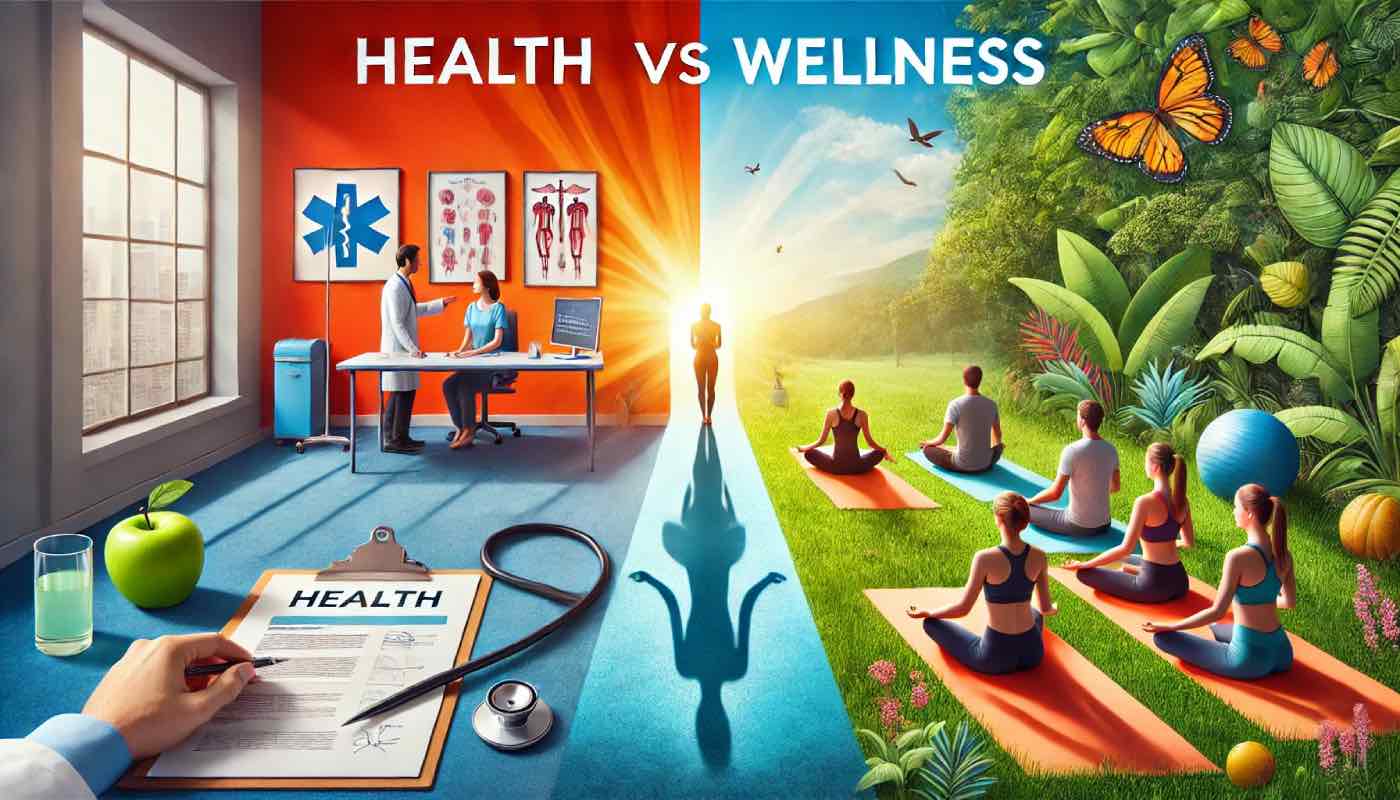Most people don’t realize the difference between health and wellness and how unique they both are. The World Health Organization defines health as “a state of complete physical, mental, and social well-being and not merely the absence of disease or infirmity.”
Health mainly deals with your body’s physical condition. Wellness, on the other hand, covers much more ground. The Global Wellness Institute sees wellness as “the active pursuit of activities, choices, and lifestyles that lead to a state of comprehensive health.” Wellness goes beyond health and includes physical, social, spiritual, emotional, intellectual, environmental, and occupational aspects of life.
This guide breaks down the basics, showing how they’re different and why it matters. You’ll also discover simple, practical tips to improve your health and start your journey toward a more balanced and fulfilling life.
Contents
- 1 Health vs Wellness: Key Differences
- 2 Core Differences Between Health and Wellness
- 3 Interconnected Nature of Health and Wellness
- 4 Practical Steps to Improve Both Health and Wellness
- 5 Difference Between Health and Wellness FAQ
- 5.1 What is the difference between health care and wellness care?
- 5.2 Is health a part of wellness?
- 5.3 How are health and well-being different?
- 5.4 What is a difference between health and wellness?
- 5.5 What is the best description of wellness?
- 5.6 Are mental health and wellness the same?
- 5.7 Is there a correlation between health and well-being?
- 5.8 What is whole health and wellness?
- 5.9 Is fitness considered health and wellness?
- 5.10 What are the four types of health and wellness?
- 5.11 Are health and wellness really related?
Health vs Wellness: Key Differences
Concepts have changed dramatically throughout history.
Traditional definition of health
Ancient civilizations saw health as a balance between physical and spiritual harmony. The World Health Organization’s 1948 definition brought a big change. They described health as “a state of complete physical, mental, and social well-being and not merely the absence of disease or infirmity”.
Modern interpretation of wellness
The Global Wellness Institute sees wellness as “the active pursuit of activities, choices, and lifestyles that lead to a state of holistic health”. Wellness covers several key dimensions:
- Physical: Keeping people fed through exercise and nutrition
- Mental: Engaging with learning and creativity
- Emotional: Understanding and expressing feelings
- Spiritual: Searching for life’s meaning
- Social: Building meaningful community connections
- Environmental: Creating positive relationships with nature
How these concepts evolved over time
These concepts have developed over thousands of years. The wellness movement grew stronger during the 1960s and 1970s with guidance from innovative physicians and thinkers. Ancient healing practices from India, China, Greece, and Rome shaped modern wellness approaches substantially.
Healthcare’s viewpoint changed from seeing health as just the absence of illness to viewing wellness as an active, ongoing process. This development created a detailed understanding where health shows a state of being, while wellness represents the active process of achieving optimal well-being.
Core Differences Between Health and Wellness
Let’s get into what makes them unique and how these differences affect our approach to well-being.
State vs Active Process
Health shows your physical, mental, and social condition at any specific moment. Your wellness, however, is a continuous experience of making conscious choices and taking action. This key difference shows that while health is your current condition at a specific time, wellness reflects all the decisions you make to live your best life.
Reactive vs Proactive Approach
We spend most of our healthcare resources treating existing conditions and managing symptoms. The numbers tell the story – three-quarters of US health spending goes to chronic disease treatment. In stark comparison to this, wellness puts prevention first and helps you stay healthy before problems show up. This forward-thinking approach includes:
- Regular health screenings and check-ups
- Lifestyle changes that prevent disease
- Early intervention strategies
- Learning programs that help you make better decisions
Measurement and Assessment Methods
Doctors use objective clinical measurements like blood tests and diagnostic screenings to check your health. On top of that, it takes both measurable data and personal feedback to assess wellness properly. The World Health Organization has created detailed assessment tools that look at:
Your physical function and mental health status, how satisfied you are with life, and your social support system. Modern wellness wheels also assess eight core areas: emotional, financial, environmental, intellectual, occupational, physical, social, and spiritual aspects.
They work hand in hand to give you a full picture of your well-being. Each plays its own part in helping you live your best life. Recommend you look into wellness centers if you aren’t already familiar.
Interconnected Nature of Health and Wellness
Physical and mental well-being are deeply connected and shape our quality of life. Research shows that physical and mental health conditions can affect and amplify each other.
How health influences wellness
Physical health issues can trigger a chain reaction that affects mental wellness. People with physical ailments such as candida often face mental health challenges. Chronic pain or physical limitations can take a toll on emotional well-being, social connections, and life satisfaction. Two in three people now recognize how mental and physical health work together.
Impact of wellness on health outcomes
The connection between wellness practices and health outcomes shows clear benefits. Good mental well-being helps with weight management and physical fitness. Regular exercise boosts your physical wellness by:
- Boosting immune system function
- Lowering stress and anxiety levels
- Making digestive health stronger
- Making skin healthier through the gut-skin axis
Creating a balanced approach
They work best together, not as separate parts of life. Research shows that good self-stewardship benefits us and our loved ones. Finding the right balance between wellness dimensions matters more than trying to balance them equally.
A complete wellness strategy works on several aspects of well-being at once. New habits take about 66 days to stick, and lifestyle changes work better when multiple strategies come together. The time invested in balanced wellness practices pays off well, showing results that match other traditional public health programs.
Practical Steps to Improve Both Health and Wellness
Better living starts with blending good habits into your daily life. Research shows that new habits take about 66 days to stick. You should start with changes you can handle.
Daily habits for optimal health
Quality sleep forms the base of good health. Adults need 7-9 hours of sleep each night. Your morning routine sets the day’s tone with these simple steps:
- Hydration upon waking
- Morning stretches
- Nutritious breakfast
- Brief mindfulness practice
Good nutrition plays a vital role in your health. Meal planning and balanced portions help you stick to healthy eating. Your meals should include whole foods, lean proteins, and plenty of fruits and vegetables.
Wellness practices for long-term wellbeing
Your mental wellness needs regular attention through mindfulness and stress management. Brief periods of meditation or deep breathing can substantially lower stress levels. People notice better focus and less anxiety soon after they start these practices.
Physical activity builds the foundation of lasting wellness. Dr. Martin Gibala’s research shows that one minute of vigorous movement three to four times daily brings substantial health benefits. This approach makes exercise more available to people with packed schedules.
Integration strategies for busy lifestyles
A balanced approach needs smart planning. Studies show all but one of these people feel overwhelmed by traditional exercise guidelines. The answer lies in small, steady changes instead of big overhauls.
Smart time management helps you keep wellness routines. Breaking self-care into shorter segments throughout your day works better. Quick walks or desk exercises during lunch breaks keep you moving without disrupting work.
Difference Between Health and Wellness FAQ
What is the difference between health care and wellness care?
Health care focuses primarily on diagnosing and treating illnesses (see heavy metal toxicity) or injuries, often addressing specific symptoms or conditions. Wellness care, on the other hand, emphasizes prevention and improving overall quality of life by supporting the body, mind, and spirit. While health care treats problems as they arise, wellness care is more proactive, aiming to keep you healthy and balanced.
Is health a part of wellness?
Yes, health is an essential part of wellness, but wellness extends beyond physical health. Wellness also includes emotional, mental, social, and spiritual well-being. When you embrace wellness, you prioritize a lifestyle that nurtures all these aspects, not just physical health.
How are health and well-being different?
Health refers to the state of your physical body, including the absence of illness or disease. Well-being is a broader concept that encompasses mental, emotional, and social contentment. While health is more clinical, well-being captures the quality of life and overall happiness.
What is a difference between health and wellness?
The key difference between health and wellness is that health often focuses on the physical state of the body, such as being free from disease. Wellness, however, is a holistic concept that includes a balance of mental, emotional, and physical health. Wellness vs health reflects this broader perspective of living a fulfilling and balanced life.
What is the best description of wellness?
The best description of wellness is a proactive, intentional pursuit of activities and choices that support physical, mental, and emotional balance. Wellness encompasses not just the absence of illness but also the presence of positive habits and a vibrant lifestyle. It’s about thriving rather than just surviving.
Are mental health and wellness the same?
Mental health and wellness are closely related but not the same. Mental health refers to the state of your emotional and psychological well-being, while wellness includes mental health as one of many aspects. Wellness promotes balance across all areas of life, with mental health being a key factor in achieving that harmony.
Is there a correlation between health and well-being?
Yes, there is a strong correlation between health and well-being. When you are physically healthy, you are more likely to experience emotional and mental stability. Similarly, nurturing your well-being through stress management, relationships, and self-care can positively impact your overall health.
What is whole health and wellness?
Whole health and wellness is an approach that considers the body, mind, and spirit as interconnected. This concept emphasizes that achieving optimal health requires attention to all areas of life, including nutrition, mental clarity, emotional resilience, and spiritual practices. Whole health embodies the difference between health and wellness, integrating them seamlessly.
Is fitness considered health and wellness?
Yes, fitness is a critical component of both health and wellness. Regular physical activity contributes to physical health by improving cardiovascular strength, muscle tone, and overall energy levels. It also supports wellness by enhancing mood, reducing stress, and promoting a balanced lifestyle.
What are the four types of health and wellness?
The four types of health and wellness include physical, mental, emotional, and social well-being. Physical health addresses your body’s functionality, mental health focuses on cognitive and emotional stability, emotional wellness involves understanding and managing feelings, and social wellness prioritizes healthy relationships and community connections.
Absolutely, health and wellness are deeply related because they both aim to improve quality of life. Health vs wellness discussions highlight that while health is foundational to living well, wellness takes it further by addressing broader aspects of life, such as happiness, purpose, and social harmony.



